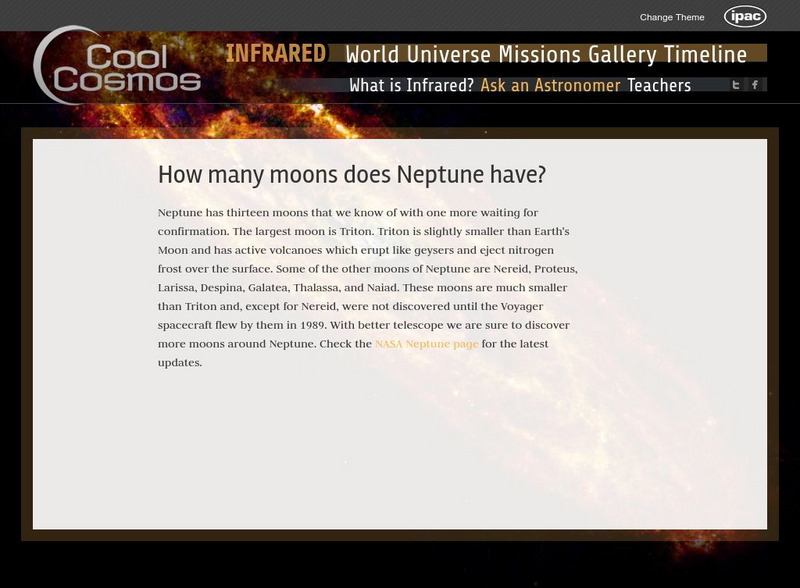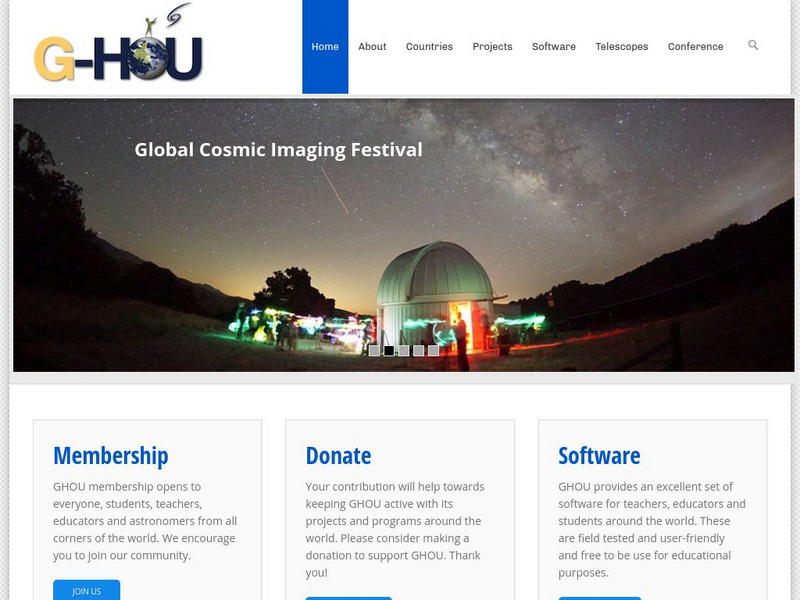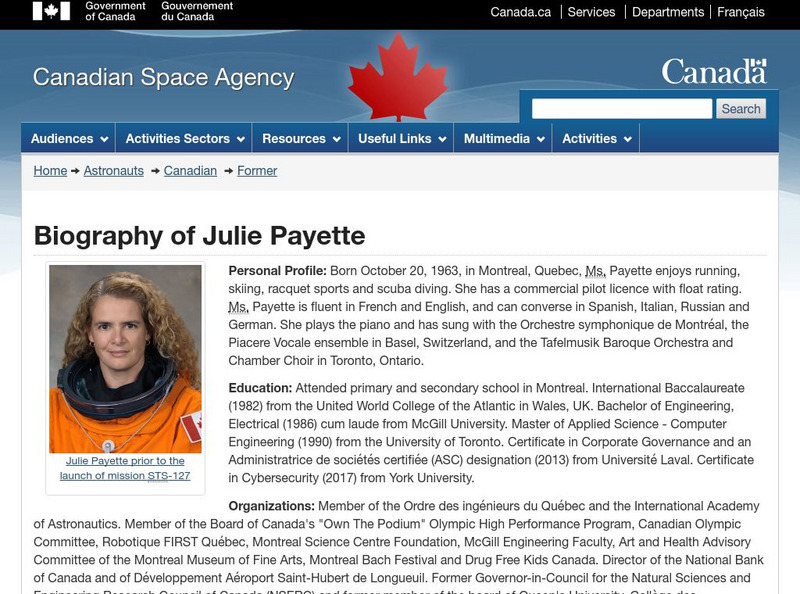Hi, what do you want to do?
NASA
Nasa: Imagine the Universe: Imagine the Universe!
This helpful site provides everything you want to know about studying the universe. Take a look at the tools and methods scientists use to study the universe, discover some of the objects that make up our universe, learn how scientists...
Vision Learning
Visionlearning: Mechanics: Gravity: Newtonian Relationships
Explanation of how astronomers and scientist developed the current theories of gravity.
PBS
Pbs Learning Media: Why Doesn't the Moon Fall Down?
In this animated video segment adapted from NASA, astronomer Doris Daou explains how the forces of speed and gravity keep the moon in a constant orbit around Earth. [1:36]
PBS
Pbs Learning Media: How Big Is the Universe?
In this media-rich essay from the NOVA Web site, astronomer Brent Tully of the University of Hawaii walks you through the latest scientific theories about the size of the universe.
Harvard University
Chandra Special Features
Chandra allows astronomers to view our galaxy and beyond in ways only dreamt of before. 14 interactive features are offered in this exciting look at cosmic phenomena.
The National Gallery (UK)
The National Gallery: Celestial Globe
As part of a larger exhibit on science and the history of scientific instruments, this site examines a detail from a painting by Olivier van Deuren which features a celestial globe. The globe is only one feature of the larger, more...
California Institute of Technology
Cool Cosmos: Ask an Astronomer
Explore the night sky with some help from Cool Cosmos. This site provides a list of the most frequently asked questions about the things we can see at night. Click on the question link and delve into the beauty of evening.
California Institute of Technology
Cal Tech: Cool Cosmos: Ask an Astronomer: How Many Moons Does Neptune Have?
Resource provides a brief answer to this question.
Robin Chew
Lucid Cafe: Polish Cleric and Astronomer
This site from the Lucid Cafe contains a short bibliography of Nicholas Copernicus. The information, though it is brief, is very factual and worth checking out with great links throughout for additional information on related subjects.
Stanford University
Stanford Univ/gravity Probe B/relativity Q&a
Click "Relativity Q & A". Over 200 questions and answers dealing with relativity (special and general), answered by NASA scientist Dr. Sten Odenwald. Answers are generally one paragraph, very clear and coherent.
Rice University
Galileo Project: The Galileo Project
Rice University offers an impressive online project about Galileo Galilei, his life and work. Includes a glossary of terms, a timeline, maps, pictures, primary texts, family letters, and sketches.
Sonoma State University
Sonoma State University: 1938 Bruce Medalist: Edwin Hubble
Site honoring the winners of the Catherine Wolf Bruce medal for lifetime contributions to astronomy. Edwin Hubble, the award winner in 1938, is highlighted in a biography.
Microscopy UK
Microscopy Uk: Robert Hooke: Father of Modern Science and an Unsung Hero
An excellent biography, including all major periods of Robert Hooke's life, works, inventions, career, and even his battle with Newton.
Other
The Astronomy Cafe: A Guide Book to Astronomy
Investigate the field of astronomy in this book by Sten Odenwald where he talks about his own and others' experiences, as well as his experiences doing research.
NASA
Nasa: Astronomy Picture of the Day: Edwin Hubble 1889 1953
Part of the NASA website, this is a reprint of an article in the Journal of the Royal Astronomical Society of Canada about Edwin Hubble's life and accomplishments, stressing his role in the development of modern astronomy.
Other
Hands on Universe (Hou)
HOU trains teachers in how to use astronomy tools and its curriculum materials for science education. HOU is now part of GHOU, or Global Hands-On Universe, and is linked to astronomy scientists in countries all over the world. A world...
Scientific American
Sci Am: Search for Extraterrestrial Intelligence
Carl Sagan and Frank Drake make a case for exploring space to discover extraterrestrial intelligence.
Government of Canada
Canadian Space Agency: Canadian Astronauts: Julie Payette
Julie Payette flew on Space Shuttle Discovery and was the first Canadian to participate in an ISS assembly mission and to board the Space Station. This comprehensive biography describes her professional career.
Blackdog Media
Classic Reader: Rubaiyat of Omar Khayyam by Omar Khayyam
This is the full text of the poem Rubaiyat of Omar Khayyam by Omar Khayyam; included are an introduction, the first edition, the fifth edition, and notes.
PBS
Pbs: Africans in America: Benjamin Banneker
This website describes the life of Benjamin Banneker, a free and educated black man from Baltimore, Maryland. It describes his many accomplishments.
Other
Explorable: Ancient Astronomy, Science and the Ancient Greeks
Discusses the influences of other cultures on ancient Greek astronomers, and the advances made by the Greeks. It highlights major astronomers and those who contributed important ideas from the 6th to the 2nd centuries BC, including...
Other
European Southern Observatory: La Silla Paranal Observatory
Paranal Observatory is an astronomical observatory operated by the European Southern Observatory (ESO). It is located in high on a mountain in the Chilean desert. Although the site is geared toward the professional astronomer, you can...
BBC
Bbc: Dark Matter
A clear explanation of how dark matter was discovered and why it is important to astronomers.
Agnes Scott College
Agnes Scott College: Hypatia
The life and accomplishments of Hypatia-- the Egyptian mathematician, astronomer, and philosopher-- are documented in this synopsis. While the focus is on earlier events in her life, information is also provided on her contributions to...
Other popular searches
- Famous Astronomers
- Early Astronomers
- Major Astronomers
- Ancient Astronomers
- Greek Astronomers
- Report on Astronomers
- Astronomers Measure Distance
- Women Astronomers
- Female Astronomers
- Fumes Astronomers
- Five Early Astronomers
- Famous Astronomers Quizes





















